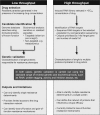Genetic dissection of drug resistance in trypanosomes
- PMID: 23552488
- PMCID: PMC3759293
- DOI: 10.1017/S003118201300022X
Genetic dissection of drug resistance in trypanosomes
Abstract
The trypanosomes cause two neglected tropical diseases, Chagas disease in the Americas and African trypanosomiasis in sub-Saharan Africa. Over recent years a raft of molecular tools have been developed enabling the genetic dissection of many aspects of trypanosome biology, including the mechanisms underlying resistance to some of the current clinical and veterinary drugs. This has led to the identification and characterization of key resistance determinants, including transporters for the anti-Trypanosoma brucei drugs, melarsoprol, pentamidine and eflornithine, and the activator of nifurtimox-benznidazole, the anti-Trypanosoma cruzi drugs. More recently, advances in sequencing technology, combined with the development of RNA interference libraries in the clinically relevant bloodstream form of T. brucei have led to an exponential increase in the number of proteins known to interact either directly or indirectly with the anti-trypanosomal drugs. In this review, we discuss these findings and the technological developments that are set to further revolutionise our understanding of drug-trypanosome interactions. The new knowledge gained should inform the development of novel interventions against the devastating diseases caused by these parasites.
Figures



References
Publication types
MeSH terms
Substances
Grants and funding
LinkOut - more resources
Full Text Sources
Other Literature Sources
Medical

